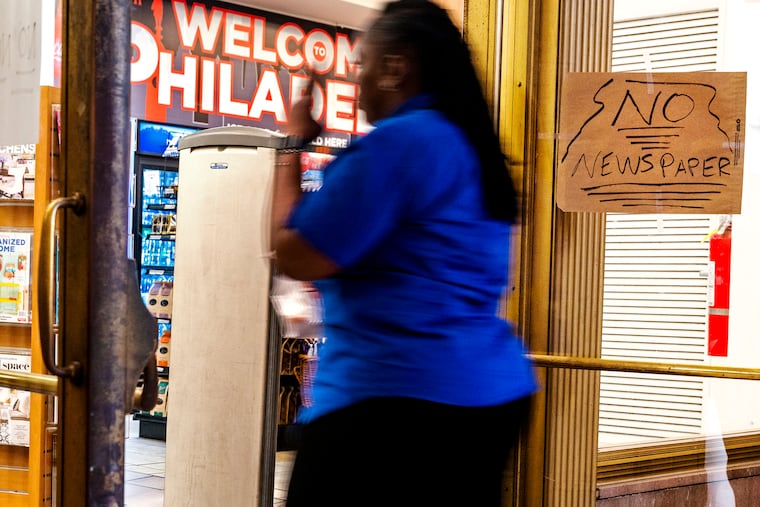At Philadelphia’s 30th Street Station, the last newsstand has stopped selling newspapers
The explanation, sadly, is old news. Nearly no one was buying them.

The handwritten sign hung on the door of the newsstand at 30th Street Station. It offered one final headline from a shop that will carry no more.
“No newspapers,” it read, underlined four times for emphasis.
That’s because earlier this month Faber, the New Jersey-based newsstand and bookseller, stopped selling newspapers at its 30th Street location. The store’s shelves remain stocked with magazines, periodicals, books, snacks, greeting cards, and travel trinkets. But the iconic station’s sole newsagent is now a newsstand without newspapers.
The explanation, sadly, is old news. Nearly no one was buying them.
“We weren’t making any money off newspapers,” said Claudia Carr, the store manager. Corporate made the call a couple of weeks ago, she said. She was relieved to be rid of them. “We were making like pennies off newspapers.”
Slumping sales would hardly come as a surprise. Not in the Age of Smartphones. Not when the pandemic only worsened the newspaper industry’s existential struggle to survive its digital transformation. And not as newsstands themselves, like coin-operated news boxes before them, slowly disappear.
But newspaper sales had grown beyond bleak at 30th Street Station, Carr said. Each year an estimated $4 million passengers pass through the station’s soaring concourse, making it Amtrak’s third busiest hub. Meanwhile, in recent times, the stand rarely sold more than a dozen daily papers each day, Carr said. (And mostly out-of-town publications. Ouch.) Then there’s rising prices, delivery costs, and time and energy spent bundling up returns.
“It just wasn’t profitable for the company,” Carr said.
Still, under the station’s vast, gilded ceiling, it is easy to conjure days long past. Sepia-toned days when the tops of broadsheets poked over station benches. When newsagents in ink-stained aprons hollered out headlines from the city’s many daily papers.
“That’s like something from the movies,” said Zoya Azhar, 25, a Smith College alumna who interned at a newspaper as a student, and was listening to NPR as she waited for her train.
Or even to a morning in 1989, when photographer Tillman Crane, then a young graduate student, felt moved to photograph another newsstand in the center of the concourse.
“It was just this pool of light in the early morning station,” remembers Crane, who lives in Maine. He used a camera with an extended exposure for the shot, so that he captured time itself passing in the station.
“If you look closely at the images, you will see the ghosts of people walking by. And the ghosts of the newspapers that were picked up during the exposure,” he said.
The photo was something of a sensation, from 30th Street all the way to Beijing — for a time, it hung in the National Art Museum of China.
Back then, the shop was owned by Stanley Schiffman, who worked with a dog named Amtrak, a stray he had found in the station. The stacks of newspapers were enough to keep the lights on and a roof over the Schiffman children’s head, his daughter Jill recalled.
But no matter how inevitable, the decision to ditch newspapers at the historic station, which opened in 1933, evokes a certain sense of loss. At Faber, the staff has been griping about customer complaints over the lack of newspapers. Where were these people a month ago, they wonder.
“Even if you rarely bought a newspaper that way, it was part of the old way of life in the city,” said Rick Edmonds, a media business analyst for the Poynter Institute. “There’s a degree of nostalgia for how it was.”
There are still a few brave commuters who prefer news that rubs off on their fingers. During a recent morning rush hour, Clayton Johnson, a retiree from North Philadelphia, sat on a station bench with his Sudoku puzzle. He was the only person in the entire station with a newspaper. He brought one with him.
“It’s an anachronism, I guess,” he said. “But what good is a newsstand without a newspaper?”